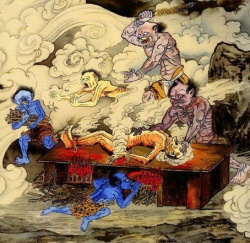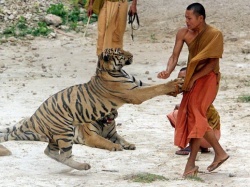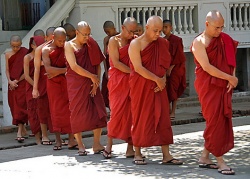Rakan.
Arakan; 阿羅漢; Rakan; 羅漢; (Japanese);Arhat; Arhan; Arahat; Arihat; Arihan; (Sanskrit)
The highest goal of those practicing Theravada Buddhism.
Those who attain Arhatship have “slain” their greed, anger and delusions, and “destroyed” their karmic residue from previous lives.
They have learned the teachings of Shaka (Historical Buddha), earned the title of Mugaku ("nothing else to learn") and achieved the highest state attainable by Shaka’s disciples.
Thus, they are no longer reborn into the world of suffering, no longer trapped in the cycle of samsara (the cycle of rebirth and redeath, the six states of existence).
To followers of Mahayana Buddhism, however, the Therevadan Arhat ranks below the Mahayana Bodhisattva on the chain of enlightenment.
The early Buddhists split into a number of factions following the death of the Historical Buddha (he died around 483 BC), each faction holding firm to its own interpretations.
Roughly 500 years later, two main schools emerged -- the Theravada and Mahayana schools.
Theravada sought to preserve the original and orthodox teachings of Gautama Buddha (the Historical Buddha).
The Mahayana tradition was more flexible and innovative.
At the time, the distinction between Theravada and Mahayana was politicized into arguments over “benefitting self” and “benefitting others.”
Mahayana adherents insisted that only by benefitting others could one hope to benefit oneself.
To Mahayana followers, the Theravada philosophy is false, for Theravada stresses “self benefit” -- practicing the monastic life for oneself, by oneself, strictly for one’s own emancipation.
Indeed, the term “Hinayana,” meaning Lesser Vehicle, was attached to the Theravada school by Mahayana adherents, who hoped to portray the Theravada teachings as inferior.
Thus, the term Hinayana is derogatory and used to denigrate Theravada traditions.
It is a term that should be (and is) avoided by most modern scholars. Main Schools for more on this early schism.
Teacher and Disciples
Legend contends that the Lord Buddha (or Sakyamuni in Sanskrit; he is no longer called Siddhartha after reaching Buddhahood) decided to keep his achievement and teachings to himself, for others would not believe or comprehend.
But his mind was changed by the appearance before him of Brahman (the chief Hindu god of that age;
Jp. = Bonten), who urged him to preach what he had learned and help others along the same path.
From that point on, until his death at age 80, the Buddha preached without interval.
The Chinese transliterated Sakyamuni as Shakamuni, but this was later shortened to Shaka in both China and Japan. “Shaka” is another word for the Historical Buddha,
for as a human, he was born into the Sakya (Shaka) clan, a tribe that ruled a small state that today is located in Tarai (Nepal) near the border with India.
His companion ascetics were the first to become his disciples, and soon afterwards they too attained enlightenment -- in Sanskrit they are known as the Arhan (Jp. = Arakan 阿羅漢),
an Indian word meaning "one who is worthy of receiving obeisance" or “slayer of enemies.”
Arhatship is the main goal of all who practice Theravada Buddhism.
The most famous of the early disciples are called the Ten Great Disciples (Jūdai Deshi 十大弟子), and they played a major role in Buddhism’s early development and transmission within India.
Source
http://www.onmarkproductions.com/html/rakan-arhat-lohan.shtml




